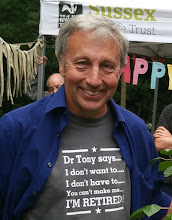Well the National park is here and, while the majority of people are delighted about this, there are a few who are less than pleased. To read the media one might be excused for thinking that the years of work to get the Park had been marred by unpleasant antagonism between the “pros” and the “antis”. You can perhaps imagine a clash of the titans with the irresistible force battling against the immovable object!
Maybe I am naïve. Perhaps I do insist on solidly fixing my rose-tinted spectacles in front of my eyes, but I don’t see this issue as such an aggressive conflict. Yes, there may have been the occasional rant but, generally speaking, any opposing views have been very polite and “English”. People have heard each others views, recognised differences and, rather than putting up barriers, have got on with life in areas where they do agree.
It may have seemed hard, sometimes, if I was unable to persuade people about the Park but, over the years, I have come to the conclusion that this relatively well-handled difference has actually led to a kind of creative tension. With most people in favour but others against (but, generally, people are trying to get the best for the Downs) it means that the approaches are properly tested and whatever comes out at the end should be the best solution.
I will give a couple of examples to explain what I mean.
In general it is true to say that while conservation organisations have been in favour, many farmers, landowners and their representatives have been against. In my experience, however, this has been more a disagreement amongst friends than a clash of opposites. Conservation groups are not anti-farmer, and farmers are not anti-conservation (indeed the distinction between farmer and conservationist is itself blurred). Whilst I do not agree with the opposition from some landowners, their concerns are certainly legitimate. The point now is that we should work together so that their concerns are not realised. Farmers and landowners should not be disadvantaged by being in the Park. These are the very people who are looking after this nationally important landscape so the National Park should aim to provide improved mechanisms (whether grants, incentive schemes, improved markets or support for diversification schemes) to support environmentally-friendly farming. Farmers should do well as a result of being in a National Park. Ensuring this is the case should be the job of all involved in setting up the Park.
It is also clear that some of the Local Authorities have been firmly against the National Park, and have fought hard to prevent it. Whilst we disagree on this, these same Authorities have a good track record in other environmental matters (of course we would always lobby for them to do better but when you compare with others, these are pretty good Councils). For example, take the West Sussex County Council – the leader of the case against the Park. We have been able to put this disagreement to one side for nearly 20 years and the practice is that the County Council has been one of the most positive supporters of the Sussex Biodiversity Partnership and the Biodiversity Record Centre, they have one of the best systems to protect Sites of Nature Conservation Importance, have supported woodland management and hedgerow planting, have assisted us in major landscape projects and included us in discussions on key environmental issues. Nobody has slammed any doors because we disagree on the Park. Their opposition has probably meant that we have had to think carefully about how planning matters could be handled and the proposed outcome of delegating day to day planning back to Local Authorities could be a good solution.
I am confident that a National Park for the South Downs does provide the best way of looking after this landscape and its wildlife. The more important thing now, however, is that a decision has been made. I say to those who remain unhappy, sometimes it is better to have a decision than it is to have no decision – even if you do not like the outcome. At least there is now some certainty so we can plan for the future.
My conclusion from this is that, at the end of the day, there will be mostly the same people sitting around roughly the same table discussing broadly the same issues, and all concerned want the best solution for the Downs. The only difference is that we consider that a National Park will give us the best way of achieving this. A new, exciting chapter has been opened in the history of the South Downs and it is down to all of us to make best use of this opportunity.
Subscribe to:
Post Comments (Atom)

1 comment:
Well I for one was delighted, especially as the Weald was included.
Post a Comment